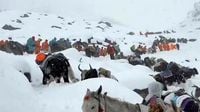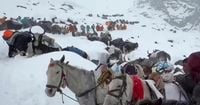Early October 2025 brought an unexpected and harrowing ordeal for hundreds of hikers and climbers across the mountainous regions of western China and neighboring Nepal, as early-season snowstorms swept in with little warning. What should have been a week of adventure and celebration for many—timed with China’s weeklong national holiday—turned into a race against time and the elements, with search and rescue teams scrambling to reach those stranded by the severe weather.
According to the Associated Press, the brunt of the storms hit two key areas in western China: the base of Mount Everest, where several hundred hikers found themselves trapped, and the remote Qilian Mountains in Qinghai province, where another group faced life-threatening conditions. The situation was compounded by the closure of trails in a third region, the Kanas scenic area in Xinjiang, after a separate snowstorm left motorists stranded on a nearby highway. Meanwhile, tragedy struck in Nepal, where a South Korean climber died after being caught in a powerful storm while attempting to summit Mera Peak, a 6,476-meter (21,250-foot) Himalayan mountain just south of Everest. The Nepal Mountaineering Association confirmed his death on October 7, 2025, following reports that he had gone missing over the weekend near the summit. Other climbers on Mera Peak were reported safe.
The severe weather arrived suddenly on the afternoon of October 4, intensifying dramatically overnight. Hikers on the Chinese side of Mount Everest, camped at altitudes above 4,900 meters (16,076 feet), were caught off guard. One hiker, identified only by the surname Dong, recounted the experience to the Xiaoxiang Morning Herald: “I had never encountered such a severe storm with heavy snow and lightning flashes.” The precipitation began Saturday afternoon, Dong said, and by nightfall, the conditions had become dire. State broadcaster CCTV reported that by late Monday, October 6, 350 people had managed to descend safely, while more than 200 others were still being guided to a designated meeting point by rescue teams. Many of the stranded hikers had been staying overnight in tents, hoping the storm would pass.
Mount Everest, the world’s tallest peak at 8,850 meters (29,000 feet), straddles the border between China and Nepal. The Chinese side, at the southern edge of Tibet, is a popular destination for both seasoned mountaineers and adventure-seeking tourists, especially during national holidays. The sudden storm, however, underscored the unpredictable and often unforgiving nature of high-altitude weather.
Elsewhere in China, the Qilian Mountains in Qinghai province became the site of another dramatic rescue operation. On October 5, search efforts—including the use of drones—were launched after hikers reported being trapped in Laohugou, a remote valley in Menyuan county. The terrain there is rugged, undeveloped, and sits at an average altitude of over 4,000 meters (13,100 feet), making any rescue operation a logistical challenge. State media reported that continuous snowfall, unpredictable weather, and the sheer remoteness of the area complicated the search. By Tuesday, authorities confirmed that one person had died from hypothermia and altitude sickness, while 213 others had been evacuated to safety.
The influx of hikers into the Qilian Mountains was, in part, attributed to social media. According to the official Xinhua News Agency, many people were drawn to the area after seeing it promoted online, perhaps underestimating the risks posed by the high altitude and unpredictable weather. In response to the crisis, the Menyuan county government issued a notice prohibiting hiking in the area, stating that the hikers had entered illegally. This move was aimed at preventing further incidents and highlighting the dangers of venturing into such regions without adequate preparation or official clearance.
The Kanas scenic area in the Xinjiang region, near the border with Kazakhstan, was not spared either. After a snowstorm on October 5 stranded motorists on a nearby highway, authorities closed the area on October 7. Fortunately, the road was cleared by the following day, allowing those trapped to continue their journeys without further incident.
Across all affected regions, search and rescue operations were swift and multifaceted. In Tibet, villagers with oxen and horses ascended the snowy slopes to reach trapped tourists, as captured in dramatic photographs released by local organizations. The use of drones in Qinghai provided a technological edge, helping rescuers navigate the treacherous landscape and locate stranded hikers more efficiently. Yet, despite these efforts, the sheer scale of the storms and the number of people involved made the operations both urgent and precarious.
For many, the events of early October served as a stark reminder of the power of nature in some of the world’s most breathtaking—and dangerous—landscapes. The Tibetan plateau, stretching from the Himalayas on the Nepal border to Qinghai and Xinjiang, is renowned for its snow-capped mountains and crystal-clear lakes. It is also the source of major rivers like the Yangtze and Mekong. But its beauty comes with inherent risks, especially as more tourists seek adventure in increasingly remote areas.
The Mount Everest region, in particular, has long been a magnet for climbers and trekkers from around the world. Yet, as this incident shows, even the best-laid plans can be upended by sudden shifts in weather. The hikers stranded at Everest were not attempting to summit the peak but were instead staying at tourist campsites, underscoring that danger is not reserved only for elite mountaineers. The South Korean climber’s death on Mera Peak, meanwhile, was a sobering moment for Nepal’s mountaineering community, which is accustomed to both triumph and tragedy during the busy autumn climbing season.
Looking ahead, officials in both China and Nepal are urging visitors to heed weather warnings, respect local regulations, and prepare thoroughly before venturing into high-altitude regions. The Menyuan county government’s decision to ban hiking in certain areas may prove controversial among adventure enthusiasts, but it reflects a growing recognition of the need for safety and oversight as tourism continues to expand into previously inaccessible terrain.
As search and rescue teams wrap up their operations and survivors recount their experiences, the early October snowstorms of 2025 will likely be remembered as a turning point—one that highlighted both the allure and the peril of the world’s highest mountains.


